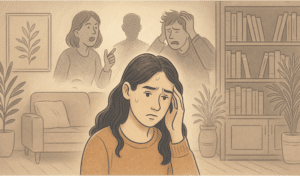Key Takeaways
- Self-harm is a complex coping mechanism affecting approximately 660,000 individuals annually, with cutting being the most prevalent form of self-injury.
- Cognitive Behavioral Therapy (CBT) provides a structured approach to transforming destructive thought patterns and neural pathways associated with self-harming behaviors.
- Dialectical Behavior Therapy (DBT) provides a comprehensive framework for emotional regulation through mindfulness, distress tolerance, and interpersonal effectiveness skills.
- Multiple therapeutic approaches, including mindfulness-based therapies and psychodynamic therapy, can be used to understand and manage self-destructive impulses.
- A Mission for Michael (AMFM) provides specialized, compassionate mental health treatment across California, Washington, and Virginia, offering personalized care for individuals struggling with self-harm.
Understanding Self-Harm
Self-harm is a complex coping mechanism that individuals use to manage overwhelming emotional pain, stress, or trauma. This intentional act of self-injury is not typically a suicide attempt, but a way to express intense internal struggles or seek temporary relief from emotional distress.
Approximately 660,000 emergency room visits were related to self-injury in 2021, as reported by the CDC. Among those who self-harm, cutting remains the most frequent behavior, occurring in 70%-90% of cases, followed by hitting or head-banging (21%-44%) and burning (15%-35%). These statistics underscore the prevalence and complexity of self-harming behaviors.
While deeply concerning, self-harm can be effectively addressed through professional therapeutic interventions that provide compassionate, targeted support.
| A Mission For Michael: Expert Mental Health Care Founded in 2010, A Mission For Michael (AMFM) offers specialized mental health care across Southern California, Washington, and Virginia. Our accredited facilities provide residential and outpatient programs, utilizing evidence-based therapies such as CBT, DBT, and EMDR. Our dedicated team of licensed professionals ensures every client receives the best care possible, supported by accreditations from The Joint Commission and the California Department of Health Care Services. We are committed to safety and personalized treatment plans. Start your recovery journey with AMFM today! |
1. Cognitive Behavioral Therapy (CBT)
Foundations of CBT
CBT represents a sophisticated approach to addressing self-harming behaviors by understanding the intricate relationship between thoughts, emotions, and actions. This therapeutic method provides individuals with a structured framework to recognize and transform destructive thought patterns that contribute to self-injury.
Neurological Mechanisms of Change
Neurological research reveals that individuals who self-harm often experience heightened emotional reactivity and reduced cognitive flexibility. CBT interventions work directly to reshape neural pathways, teaching patients to interrupt automatic negative thought sequences and develop more adaptive cognitive responses.
Therapeutic Process and Patient Collaboration
The therapeutic process involves a comprehensive assessment of emotional triggers, thought patterns, and behavioral sequences. Therapists collaborate closely with patients to identify the precise moments when self-harming thoughts emerge, developing metacognitive awareness that becomes a critical tool in interrupting destructive behavioral cycles.
2. Dialectical Behavior Therapy (DBT)
Comprehensive Emotional Intervention
DBT is a powerful intervention specifically designed to address complex emotional challenges. Originally developed to treat borderline personality disorder, DBT has proven exceptionally effective for individuals struggling with persistent self-harming behaviors.
Neurobiological Perspective on Emotional Regulation
Unlike traditional therapeutic approaches, DBT provides a unique neurobiological perspective on emotional dysregulation. The therapy focuses on four critical skill development areas: mindfulness, distress tolerance, emotion regulation, and interpersonal effectiveness. These interconnected approaches help individuals develop a more balanced and resilient approach to emotional experiences.
Clinical Effectiveness and Transformative Potential
Clinical studies consistently demonstrate DBT’s effectiveness in reducing self-harming behaviors, decreasing psychiatric hospitalizations, and improving overall emotional stability. By teaching patients to accept their current emotional state while simultaneously working to create positive changes, DBT provides a comprehensive framework for emotional healing.
3. Mindfulness-Based Therapies

Mindfulness practices help manage distress, reduce impulsivity, and foster emotional regulation in self-harm treatment.
Neurological Foundations of Awareness
Mindfulness-based interventions provide a sophisticated approach to understanding and managing self-harming impulses. Neurological research reveals that consistent mindfulness practice can fundamentally reshape how individuals experience and process emotional distress.
Cultivating Emotional Observation
These therapeutic approaches teach individuals to observe their thoughts and emotions without judgment, creating a compassionate space for understanding internal experiences. Techniques such as Mindfulness-Based Cognitive Therapy help patients develop metacognitive awareness, recognize emotional triggers, and create space between emotional impulses and actions.
Empirical Support for Mindful Healing
Empirical studies indicate that mindfulness interventions can significantly reduce the frequency of self-harming behaviors, improve emotional regulation, and enhance overall psychological resilience. By cultivating a non-judgmental awareness of internal experiences, patients can interrupt automatic patterns that lead to self-destruction.
4. Psychodynamic Therapy
Exploring Unconscious Emotional Patterns
Psychodynamic therapy provides a profound, introspective approach to understanding self-harm by exploring unconscious emotional patterns and historical experiences. This method helps individuals uncover deep-rooted motivations behind self-destructive behaviors through a comprehensive exploration of their emotions.
Therapeutic Exploration of Emotional Origins
The therapeutic process focuses on understanding early life experiences, relationships, and unconscious emotional patterns. Therapists guide patients through a careful examination of how past experiences shape current emotional responses, helping them develop more adaptive ways of processing emotional pain.
Transformative Potential of Deep Exploration
Research suggests that psychodynamic approaches can provide comprehensive emotional understanding, address underlying psychological conflicts, and develop more mature coping mechanisms. By bringing unconscious motivations to light, patients can begin to understand and transform the root causes of their self-harming behaviors.
5. Problem-Solving Therapy
Practical Approach to Emotional Management
Problem-Solving Therapy provides a practical, action-oriented method for managing self-harm. This therapeutic approach transforms self-harm from a coping mechanism to an opportunity for emotional growth by teaching individuals more effective ways of addressing emotional challenges.
Strategic Emotional Problem-Solving
Therapists guide patients through a systematic approach to emotional management, helping them identify specific problems, generate alternative solutions, and develop strategic decision-making skills. The focus is on creating practical methods for managing emotional distress without resorting to self-destructive behaviors.
Empirical Support for Skill-Based Intervention
Clinical research indicates that problem-solving therapy can reduce self-harming behaviors, improve emotional regulation, and enhance cognitive flexibility. By providing patients with concrete tools for managing emotional challenges, this approach empowers individuals to develop long-term adaptive skills.
Choose A Mission for Michael to Treat Self-Harm Triggers

Professional therapy can uncover and address the root causes of self-harm, leading to long-term healing.
At A Mission for Michael (AMFM), we recognize that self-harm is a complex emotional challenge that requires individualized and compassionate mental health support. Self-injurious behaviors are often misunderstood and perceived as attention-seeking, but in reality, they represent a profound struggle with overwhelming emotions and internal pain.

Our treatment centers provide comprehensive care for self-harm recovery, addressing emotional triggers with professional support.
Our treatment centers in California, Washington, and Virginia provide comprehensive care for individuals experiencing self-harm, understanding that each person’s journey is unique. We offer specialized mental health treatment programs designed to address the underlying causes of self-destructive behaviors with empathy, expertise, and a commitment to holistic healing.
Our approach begins with a comprehensive assessment that helps us understand the individual’s specific needs, emotional state, and the potential mental health conditions contributing to self-harming tendencies. We believe in providing tailored therapeutic interventions that address the symptoms and empower individuals to develop healthier coping mechanisms.
Start your recovery journey with AMFM today.
Frequently Asked Questions (FAQ)
What is self-harm?
Self-harm is an intentional act of causing physical injury to oneself as a way of coping with overwhelming emotional pain, stress, or trauma, without necessarily intending suicide.
How common is self-harm?
CDC data indicates that approximately 660,000 emergency room visits were related to self-injury in 2021, with cutting being the most frequent behavior (70-90% of cases).
What are the most common forms of self-harm?
The most common forms include cutting, hitting or head-banging, burning, scratching, and other behaviors that cause intentional physical harm to oneself.
Can self-harm be treated successfully?
Yes, with professional therapeutic interventions like CBT, DBT, and mindfulness-based therapies, individuals can learn healthier coping mechanisms and reduce self-harming behaviors.
What should I do if I or someone I know is self-harming?
Seek professional help from a mental health professional like AMFM, approach the individual with compassion and without judgment, and encourage them to pursue therapeutic interventions.
Why choose A Mission for Michael (AMFM) for self-harm treatment?
A Mission for Michael (AMFM) offers specialized, evidence-based mental health treatment across multiple states, providing personalized care with a compassionate approach to addressing self-harming behaviors through comprehensive therapeutic interventions.







